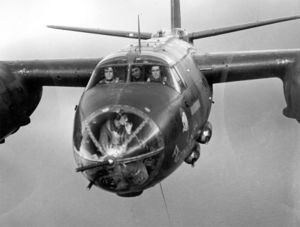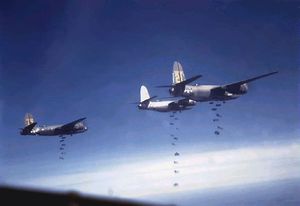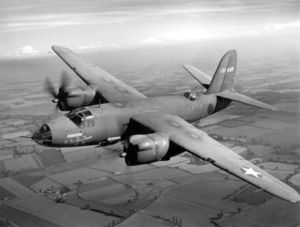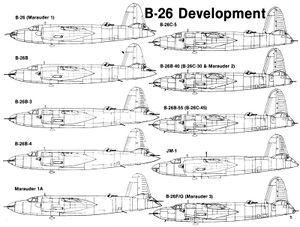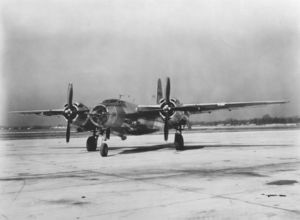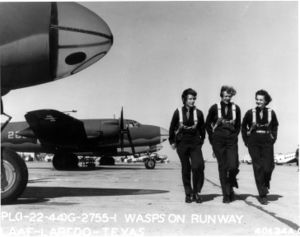PlaneSpottingWorld welcomes all new members! Please gives your ideas at the Terminal.
B-26 Marauder
| B-26 Marauder | |
|---|---|
| US Army Air Force B-26B sporting D-day ("invasion") stripes | |
| Type | Medium bomber |
| Manufacturer | Glenn L. Martin Company |
| Designed by | Peyton M. Magruder |
| Maiden flight | 25 November 1940 |
| Introduced | 1941 |
| Status | Retired |
| Primary user | United States Army Air Force |
| Produced | 1941-1945 |
| Number built | 5,288[1] |
| Unit cost | $102,659.33/B-26A [2] |
- See A-26 Invader for the plane known as the B-26 from 1948 to 1962.
The B-26 Marauder was an American World War II twin-engine medium bomber built by the Glenn L. Martin Company.
The first bomber in the Pacific theater and Aleutian Islands in 1942, it was also used in the European Theater of Operations and in the North African Campaign. The plane distinguished itself as "the chief bombardment weapon on the Western Front" according to an Army Air Forces dispatch from 1946, and also because the B-26B maintained the lowest loss record of any combat aircraft during World War II. Its loss record stands in sharp contrast to its unofficial nickname "The Widowmaker" – earned due to its high rate of accidental crashes during takeoff for the B-26A variant.
A total of 5,288 were produced between February 1941 and March 1945; 522 of these were flown by the Royal Air Force and the South African Air Force.
Contents
Design and development
In 1939, the United States Army Air Corps issued a specification for a twin-engined medium bomber, Circular Proposal 39-640. Six months later, Glenn L. Martin Company presented a design to the Air Corps. Peyton M. Magruder led the design team for this aircraft after Martin won the contract. This design, Martin Model 179, was accepted for production before a prototype even flew, due to the desperate need for medium bombers following the intensification of the war in Europe.
Once the first aircraft came off the production line in November 1940, Martin conducted tests, the results of which were promising. The first B-26 with Martin test pilot William K. "Ken" Ebel at the controls, flew on 25 November 1940 and was effectively the prototype. Soon after, it was turned over to the Army Air Corps to be service tested. It went from paper concept to working plane in less than two years.
While the B-26 was a fast plane with better performance than the contemporary B-25 Mitchell, its relatively small wing area and resulting high wing loading (the highest of any aircraft used at that time) led to tricky high-speed landings (approach at 140 mph (225 km/h) and stall at 130 mph (210 km/h) indicated airspeed). The R-2800 engines were reliable but the electric pitch change mechanism in the propellers required impeccable maintenance and was prone to failure. Failure of the mechanism placed the propeller blades in flat pitch with instant total loss of power. Due to the rotund fuselage, the B-26 engines were placed far outboard and loss of power on one side resulted in a violent snap roll flipping the aircraft on its back. This led to a high number of accidents during takeoff, thus earning B-26 the nickname "Widowmaker" by its pilots (other colorful nicknames included "Martin Murderer," "The Flying Coffin," "B-Dash-Crash," "The Flying Prostitute," (because it had no visible means of support, referring to the small wings) and "The Baltimore Whore" (because the Martin Company was located there) (Higham 1975).
The toll eventually led to a halt in production. During this time a commission of inquiry (led by then-Senator Harry Truman) was appointed to look into the problem. When Truman and the other commission members arrived at the Avon Park Bombing Range, they were greeted by the still-burning wreckage of two crashed Marauders. Indeed, the regularity of crashes by pilots training at MacDill Field — up to fifteen in one thirty day period — led to the only mildly exaggerated catchphrase, "One a day in Tampa Bay."
The resulting aircraft (designated B-26B) had a 6 ft (1.8 m) increase in wingspan, and other changes, some of which reduced the aircraft's speed. The newer version had reduced landing and stall speeds. The safety of the B-26B was an immense improvement: it had the lowest attrition rate of any aircraft used during the war. Nevertheless, it remained a challenging plane to fly and continued to be unpopular with potential crews throughout its life.
Operational Service
B-26 crews began flying combat missions in the South Pacific in spring 1942, but most of the aircraft were sent to England and the Mediterranean.
Like the B-25, the B-26 had been designed for medium-altitude bombing, but the war brought medium bombers down to treetop level, and later versions of the B-26 were equipped with a side-mounted battery of forward-firing machine guns for strafing ground targets. The low-level bombing of Utah Beach by the Marauders during the Normandy Invasion contributed to the low casualties among the American assault force.
The B-26 was phased out of Army Air Force service before the end of the war. Their last mission was flown in May 1945.
According to an article in the April edition of AOPA Pilot on Kermit Weeks's "Fantasy of Flight", the Marauder had a tendency to "hunt" in yaw. This instability is similar to "Dutch roll". This would make for a very uncomfortable ride, especially for the tail gunner.
Variants
- B-26—The first produced model of the B-26, ordered based upon design alone. Flight testing was done on the first few aircraft for about three months after delivery. The armament on this model consisted of two .30 calibre (7.62 mm) and two .50 calibre (12.7 mm) machine guns; the last model was armed with nearly three times that number. Due to a relatively small wing, the B-26 was difficult to handle at landing speeds. Approximate then cost: $80,226.80/plane (×201)
- B-26A—Incorporated changes made on the production line to the B-26, including upgrading the two .30 calibre (7.62 mm) machine guns in the nose and tail to .50 calibre (12.7 mm). A total of 52 B-26As were sent to the Britain, which were used as the Marauder Mk I. Approximate cost then: $102,659.33/aircraft (×139)
- B-26B—A model with further improvements on the B-26A. 19 were sent to Britain, which were used as the Marauder Mk IA. Production blocks of the 1883 planes built:
- AT-23A or TB-26B—208 B-26Bs converted into target tugs and gunnery trainers designated JM-1 by the Navy.
- B-26B—Single tail gun replaced with twin gun; belly-mounted "tunnel-gun" added. (×81)
- B-26B-1—Improved B-26B. (×225)
- B-26B-2—Pratt & Whitney R-2800-39 radials replaced with Pratt & Whitney R-2800-41 radials. (×96)
- B-26B-3—Larger carburetor intakes; upgrade to R-2800-43 radials. (×28)
- B-26B-4—Improved B-26B-3. (×211)
- B-26B-10 through B-26B-55—Beginning with block 10, the wingspan was increased from 65 ft to 71 ft (19.8 m to 21.6 m), to improve handling problems during landing caused by a high wing load; flaps were added outboard of the engine nacelles for this purpose also. The vertical stabiliser was heightened from 19 ft 10 in to 21 ft 6 in (6 m to 6.6 m). The armament was increased from six to twelve .50 calibre (12.7 mm) machine guns; this was done in the forward section so that the B-26 could perform strafing missions. The tail gun was upgraded from manual to power operated. Armour was added to protect the pilot and copilot. (×1242)
- CB-26B—Only 12 B-26Bs were converted into transport aircraft (all were delivered to the Marine Corps for use in the Philippines).
- B-26C—B-26C was the designation assigned to those B-26Bs that were built in Omaha, Nebraska instead of Baltimore, Maryland. 123 B-26Cs were used by the RAF as the Marauder Mk II. Approximate then cost: $138,551.27/plane (×1210)
- TB-26C —Originally designated AT-23B. Trainer modification of B-26C. (×>300)
- XB-26D— Modified B-26 used to test hot air de-icing equipment, in which heat exchangers transferred heat from engine exhaust to air circulated to the leading and trailing edges of the wing and empennage surfaces. This system, while promising, was not incorporated into any production aircraft made during World War II. (×1, converted)
- B-26E—Modified B-26B constructed to test the effectiveness of moving the dorsal gun turret from the aft fuselage to just behind the cockpit. The offensive and defensive abilities of the B-26E was tested against in combat simulations against normal aircraft. Although test showed that gains were made with the new arrangement, the gain was insignificant. After a cost analysis, it was concluded that the effort needed to convert production lines to the B-26E arrangement was not worth the effort. (×1, converted)
- B-26F—Angle of incidence of wings increased by 3.5º; fixed .50 calibre (12.7 mm) machine gun in nose removed; tail turret and armour around the turret improved. The first B-26F was produced in February of 1944. One hundred of these were B-26F-1-MAs. Starting with 42-96231, a revised oil cooler was added, along with wing bottom panels redesigned for easier removal. 200 of the 300 planes were B-26F-2s and F-6s, all of which were used by the RAF as the Marauder Mk III. The Marauder III carried the RAF serials HD402 through HD601 (ex-USAAF serials 42-96329 through 96528). The F-2 had the Bell M-6 power turret replaced by an M-6A with a flexible canvas cover over the guns. The T-1 bombsight was installed instead of the M-series sight. British bomb fusing and radio equipment were provided. (×300)
- B-26G—B-26F with standardised interior equipment. 150 planes used by the RAF as the Marauder Mk III. (×893)
- TB-26G—B-26G converted for crew training. Most, possibly all, were delivered to the United States Navy as the JM-2. (×57)
- XB-26H—Test aircraft for tandem landing gear, to see if it could be used on the Martin XB-48. (×1, converted)
- JM-1P - A small number of JM-1s were converted into photo-reconnaissance aircraft.
Operators
- Template:AUS
- Template:FRA
 South Africa: SAAF
South Africa: SAAF- Template:UK: RAF
- Template:USA: (US Army Air Corps, US Army Air Force, US Marine Corps, US Navy
Specifications (B-26G)
Data from Quest for Performance[3] and Jane's Fighting Aircraft of World War II[4]
General characteristics
- Crew: 7: 2 pilots, bombardier, navigator/radio operator, 3 gunners
- Length: 58 ft 3 in (17.8 m)
- Wingspan: 71 ft 0 in (21.65 m)
- Height: 21 ft 6 in (6.55 m)
- Wing area: 658 ft² (61.1 m²)
- Empty weight: 24,000 lb (11,000 kg)
- Loaded weight: 37,000 lb (17,000 kg)
- Powerplant: 2× Pratt & Whitney R-2800-43 radial engines, 1,900 hp (1,400 kW) each
- * Zero-lift drag coefficient: 0.0314
- Drag area: 20.66 ft² (1.92 m²)
- Aspect ratio: 7.66
Performance
- Maximum speed: 287 mph (250 knots, 460 km/h) at 5,000 ft (1,500 m)
- Cruise speed: 216 mph (188 knots, 358 km/h)
- Landing speed: 104 mph (90 knots, 167))
- Combat radius: 999 nm (1,150 mi, 1,850 km)
- Ferry range: 2,480 nm (2,850 mi, 4,590 km)
- Service ceiling: 21,000 ft (6,400 ft)
- Wing loading: 46.4 lb/ft² (228 kg/m²)
- Power/mass: 0.10 hp/lb (170 W/kg)
- Lift-to-drag ratio: 12.0
Armament
- Guns: 12× .50 in (12.7 mm) Colt-Browning machine guns
- Bombs: 4,000 lb (1,800 kg)
References
- ↑ Mendenhall, Charles. Deadly Duo. North Branch, Minnesota: Specialty Press Publishers & Wholesalers, 1981. ISBN 0-933424-22-1. Note: The 5,288 serial numbers published in this book effectively refutes the lesser count of the National Air & Space Museum.
- ↑ B-26A
- ↑ Loftin, L.K. Jr. Quest for performance: The evolution of modern aircraft. NASA SP-468. [1] Access date: 22 April 2006.
- ↑ Jane, Fred T. “The Martin Model 179 Marauder.” Jane’s Fighting Aircraft of World War II. London: Studio, 1946. ISBN 1-85170-493-0. p. 245-246.
- Baugher, Joe. "Martin B-26 Marauder". Encyclopedia of American Aircraft. [2] Access date: 5 March 2005.
- B-26 Purchase Orders from 9-20-1939 to 7-15-1943. B-26 Purchase Orders from 9-20-1939 to 7-15-1943 (PDF), Access date: 15 October 2005.
- Green, William. Famous Bombers of the Second World War (2nd ed.). New York: Doubleday, 1975. ISBN 0-356-08333-0.
- Havener, Jack. Historical Marauder Firsts. [3] Access date: 12 August 2005.
- Havener, Jack. The Martin B-26 Marauder. Murfreesboro, TN: Southern Heritage Press, 1997. ISBN 0-941072-27-4.
- Higham, Roy and Williams Carol (eds.). Flying Combat Aircraft of USAAF-USAF (Vol.1). Andrews AFB, MD: Air Force Historical Foundation, 1975. ISBN 0-8138-0325-X.
- Johnsen, Frederick A. Martin B-26 Marauder. St. Paul, MN: Specialty Press, 2000. ISBN 1-58007-029-9.
- Moench, John O. Marauder Men: An Account of the B-26 Marauder. Longwood, FL: Malia Enterprises, 1989. ISBN 1-877597-00-7.
- O'Mahony, Charles. "Me & My Gal: The Stormy Combat Romance Between a WWII Bomber Pilot and His Martin B-26." Wings, December 1994.
- Swanborough, Gordon and Bowers, Peter M. United States Navy Aircraft Since 1911. Annapolis, MD: Naval Institute Press, 1990. ISBN 0-87021-792-5.
- Tannehill, V.C. The Martin Marauder B-26. Arvada, CO: Boomerang Publishers, 1997. ISBN 0-9605900-6-4.
- Wagner, Ray. The Martin B-26B and C Marauder, Aircraft in Profile. New York: Doubleday, 1965.
External links
- B26.com (Online Memorial to Marauder Men)
- B-26 Historical Society Bibliography Guide
- B-26 Martin Marauder Historical Society
- USAF Museum
- Warbird Alley
- Fantasy of Flight's B26 at Fantasy of Flight
- 320thbg.org (320th Bomb Group in WWII)
- The Marauder Men of the Metroplex (MMM)
Photo galleries
- Personal Collection of Captain Joseph J. Merhar, Jr., c. 1943-1945 Aircraft Photos contains several photos of B-26 variants.
- Photo of a B-26 in a French museum from German Wikipedia.
Related content
Related development
Comparable aircraft
Designation sequence
- Pre-1948 USAAF/C:
- Post-1948 USAF:
- 1922-1962 Navy :
Related lists
Lists relating to aviation | |
|---|---|
| General | Timeline of aviation · Aircraft · Aircraft manufacturers · Aircraft engines · Aircraft engine manufacturers · Airports · Airlines |
| Military | Air forces · Aircraft weapons · Missiles · Unmanned aerial vehicles (UAVs) · Experimental aircraft |
| Notable incidents and accidents | Military aviation · Airliners · General aviation · Famous aviation-related deaths |
| Records | Flight airspeed record · Flight distance record · Flight altitude record · Flight endurance record · Most produced aircraft |
de:Martin B-26 es:B-26 fr:Martin B-26 Marauder it:Martin B-26 Marauder ja:B-26 (航空機) pl:Martin B-26 Marauder
